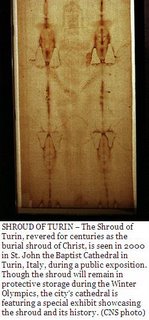Catholic News Service
 TURIN, Italy -- The Shroud of Turin has been wrapped in mystery for centuries; even modern-day science has been unable to give definitive explanations for the cloth's sepia image of a crucified man.
TURIN, Italy -- The Shroud of Turin has been wrapped in mystery for centuries; even modern-day science has been unable to give definitive explanations for the cloth's sepia image of a crucified man.According to tradition, the 14-foot by 4-foot linen cloth is the burial shroud of Jesus. The shroud has a full-length photonegative image of a man, front and back, bearing signs of wounds that correspond to the gospel accounts of the torture Jesus endured in his passion and death.
The church has never officially ruled on the shroud's authenticity, saying judgments about its age and origin belonged to scientific investigation. Scientific debates have raged for decades, and studies have led to conflicting results.
Independent carbon-14 dating tests in 1988 led scientists to conclude the cloth fibers originated between 1260 and 1390. But later tests made on threads that had been pulled from the cloth led to conclusions that the cloth held pollen grains from plants that grew in the Middle East. Also, it was determined that the herringbone-type weave was typical of the time and region where Christ lived.
Tests also indicated the presence of iron oxide, which could possibly come from dried blood in areas where the image shows the appearance of blood stains.
The shroud's history is clearly documented as of 1354, when it was placed in a church in France by Geoffrey de Charny. Some church historians believe, however, that they have traced the shroud's travels all the way back to 544, when it was kept in Edessa, now Urfa in modern-day Turkey.
The shroud has survived at least two major fires. In 1532, the chapel where it was housed in France caught fire, causing the edge of the lid of the silver casket protecting the shroud to melt and drip molten metal on the cloth, burning holes through the layers of the fabric.
A fire in 1997 erupted in Turin's Cathedral of St. John the Baptist, where the shroud has been located since 1578. The shroud was not in the chapel where the fire broke out because it had been temporarily relocated during chapel restoration. Turin's firefighters rescued the cloth, but not before some water damage had occurred.
Today, the shroud lies protected behind bulletproof glass in the cathedral chapel.
It is flat inside a casket made of a special space-age alloy created by the Italian aeronautical agency, Alenia. The casket is waterproof and fireproof and is hermetically sealed to keep out oxygen.
A large wreath of thorns sits atop the casket.
Church officials limit the removal of the cloth to very special spiritual occasions. The last time it was displayed to the public was in 2000 for the jubilee year.
- Copyright (c) 2006 Catholic News Service/U.S. Conference of Catholic Bishops
This Post's Link

No comments:
Post a Comment